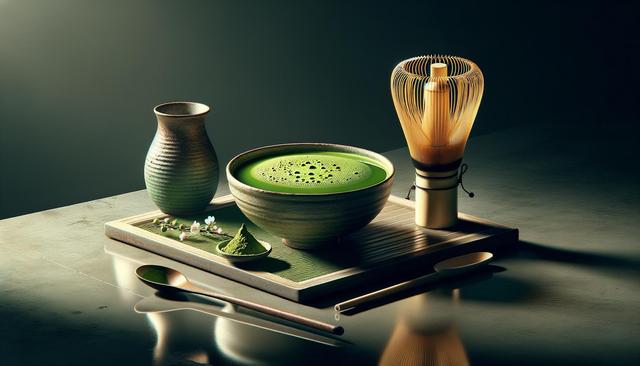What is Matcha and How is it Made?
Matcha is a type of powdered green tea that originates from Japan. Unlike traditional green teas, where leaves are steeped and then discarded, matcha involves consuming the whole leaf in powdered form, which contributes to its vibrant flavor and nutritional profile. The tea plants used for matcha are shaded from the sun for several weeks before harvesting. This process increases chlorophyll levels and enhances the production of amino acids, particularly L-theanine. Once harvested, the leaves are steamed, dried, and ground into a fine powder known as matcha powder.
When preparing matcha tea, the powder is whisked into hot water, creating a frothy and aromatic drink. This method of preparation sets it apart from other teas and contributes to its distinct identity. Authentic matcha is often associated with traditional Japanese tea ceremonies, highlighting its cultural significance. High-quality matcha, such as ippodo matcha, is typically vibrant green and smooth in texture, offering a fresh and slightly sweet taste.
Health Benefits of Drinking Matcha Tea
Drinking matcha tea is more than just a flavorful experience—it also provides a range of potential health benefits. Owing to the way matcha is cultivated and consumed, it retains a higher concentration of beneficial compounds compared to other green teas. Here are some of the most discussed health benefits associated with matcha:
- Rich in antioxidants, particularly catechins, which may help protect cells from damage.
- Contains L-theanine, an amino acid known for promoting relaxation without drowsiness.
- Provides a moderate caffeine boost, often described as smoother and longer-lasting than that from coffee.
- May support metabolism and fat oxidation when combined with regular physical activity.
Matcha powder is a popular ingredient in smoothies, lattes, and even baked goods, making it easy to incorporate into a health-conscious lifestyle. People seeking an alternative to traditional coffee often turn to matcha for its balanced energy effect and calming influence.
Types of Matcha and How to Choose
There are several varieties of matcha available, and choosing the right one can depend on your intended use and taste preferences. Typically, matcha is categorized into ceremonial grade and culinary grade. Ceremonial grade matcha is made from the youngest tea leaves and is intended for traditional tea preparation. It has a delicate flavor and is often considered among the top-rated options for drinking straight. Culinary grade matcha, on the other hand, is ideal for mixing into recipes due to its more robust flavor profile.
When selecting matcha, consider the following factors:
- Color: High-quality matcha should be a bright, vibrant green.
- Texture: A fine, smooth powder indicates careful processing.
- Origin: Matcha from renowned regions in Japan is often well-regarded.
- Packaging: Look for airtight containers to preserve freshness and flavor.
Renowned brands like ippodo matcha are often cited for their consistent quality and adherence to traditional methods. While blue matcha, made from butterfly pea flowers, isn’t technically green tea, it’s gaining popularity for its bold color and different set of health properties.
Creative Ways to Enjoy Matcha in Daily Life
Matcha’s versatility extends far beyond a simple cup of tea. This powdered green tea can be used in a wide variety of recipes and formats, allowing for creativity in the kitchen. Whether you’re starting your day or looking for an afternoon treat, there are many ways to incorporate matcha into your routine.
- Matcha lattes: A smooth blend of matcha powder with milk or plant-based alternatives.
- Smoothies: Add a teaspoon of matcha to fruit-based smoothies for an antioxidant boost.
- Baking: Matcha works well in cookies, cakes, and muffins, lending both color and a subtle earthy flavor.
- Overnight oats or chia pudding: Mix in matcha for a nutritious and colorful breakfast.
Blue matcha, often used for its visual appeal rather than its taste, can also be integrated into similar recipes. It’s caffeine-free and offers a different nutritional profile, making it suitable for evening use or for those avoiding stimulants.
Understanding Matcha Culture and Its Global Reach
Matcha tea has deep roots in Japanese culture but has found a global audience thanks to its unique qualities. The traditional Japanese tea ceremony, known as “chanoyu,” places emphasis on mindfulness, hospitality, and the aesthetic appreciation of the matcha-making process. This ceremonial approach to tea drinking reflects the cultural reverence for simplicity and harmony.
Today, matcha culture has expanded far beyond Japan. Cafes around the world now serve matcha-based drinks and desserts, and many people incorporate matcha into their wellness routines. Social media has helped popularize matcha recipes and presentation styles, making it more accessible to new audiences. The demand for high-quality matcha powder continues to grow, with consumers seeking well-regarded products such as ippodo matcha for their authenticity.
Whether you’re drawn to matcha for its flavor, health potential, or cultural significance, it’s clear that this green powder has become a global phenomenon. Its integration into modern lifestyles shows how traditional practices can evolve and thrive in a contemporary world.
Conclusion: Embracing the Matcha Experience
Matcha tea offers a unique blend of tradition, flavor, and functionality. From the meticulous cultivation of matcha powder to its many uses in modern kitchens, this tea provides a rich experience for both the palate and the mind. Whether you’re exploring matcha tee for its potential health benefits, experimenting with new recipes, or simply enjoying a moment of calm with a cup of frothy matcha, there’s something for everyone. With options ranging from ceremonial-grade matcha to colorful alternatives like blue matcha, the world of matcha continues to expand, inviting newcomers and long-time enthusiasts alike to discover its many layers.




Leave a Reply